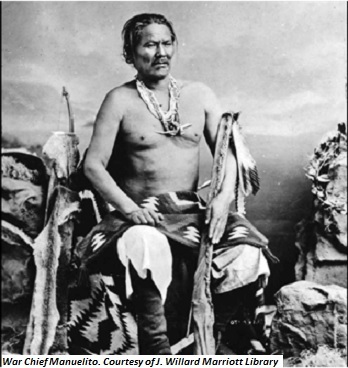Dublin Core
Title
Description
Manuelito was one of the last Navajo leaders to surrender to the US military in the late 1860s.
Born near the Bear Ears in extreme southeastern Utah, the man known to whites as Manuelito and to the Navajo, or Dine, as Man of Dark Plants Emerging and Holy Boy became one of the last Dine chiefs to resist white territorial incursions onto his people’s traditional lands. As early as the 1850s, the Navajos clashed with US Army troops in the Four Corners region, but it wasn’t until General James Carleton arrived in Navajo country in 1862 that the Navajos found themselves engulfed in full-scale warfare with the US government.
Carleton and other whites wanted the Dine land for its minerals, and hatched a plan to remove the Navajos to the Bosque Redondo in northwestern New Mexico. The job of removal went to legendary Indian fighter Kit Carson, whose scorched earth policy in Navajoland eventually led more than 8,000 Dine to take the punishing Long Walk to the Bosque. A few leaders like Manuelito, however, refused to be removed from their homeland and continued to resist Carleton’s soldiers. Hoping to quash the resistance, the general threatened to kill the Navajo headman and have his family enslaved. Soon men from Manuelito’s band began filtering into army posts to surrender, thought their chief continued the struggle. Only when Utes fighting for Carleton dispersed Manuelito’s few remaining stalwarts, and the holdouts were close to starvation did the Man of Dark Plants Emerging finally surrender at Fort Wingate. The year was 1866.
Creator
Source
Image: War Chief Manuelito in costume. Image shows Navajo war chief, Manuelito, sitting in regalia. Courtesy of J. Willard Marriott Library.
_______________
See Nancy Maryboy and David Begay. “The Navajos,” in The History of Utah’s Indian Tribes, ed. Forrest Cuch (Salt Lake City: Utah Division of Indian Affairs and Utah State Division of History, 2000); Robert S. McPherson, Navajo Land, Navajo Culture: The Utah Experience in the Twentieth Century (Norman: University of Oklahoma Press, 2001), 11-14; Dee Brown, Bury My Heart and Wounded Knee: An Indian History of the American West (New York: Henry Holt and Company, 1970), 14-36.

